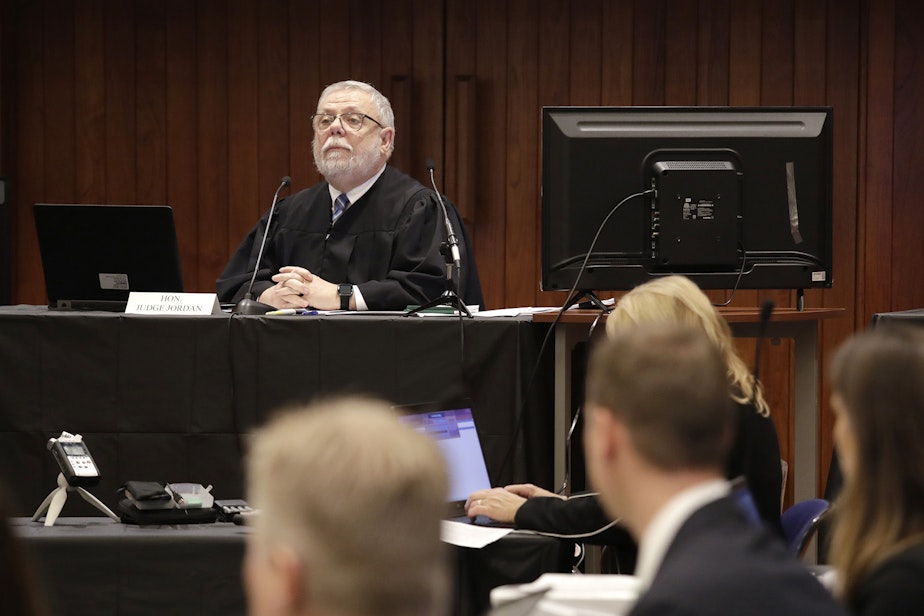Makah Tribe aims to harpoon gray whales again — 20 years after last successful hunt

Twenty years after its last successful whale hunt, the Makah Tribe is inching closer to getting to harpoon gray whales again off the Washington coast.
The National Oceanic and Atmospheric Administration is proposing to let the oceangoing tribe kill up to three gray whales a year, with a maximum of 25 whales over a decade. A federal hearing on that proposal began Thursday in Seattle and is expected to take a week.
“It's who we've always been,” Makah Tribal Council member Nate Tyler said. “People of the sea: whaling, sealing and halibut fishing.”
Nearly 15 years ago, the Makah Tribe petitioned to resume its traditional whale hunt off the remote tip of the Olympic Peninsula, as sanctioned under the Treaty of Neah Bay of 1855.
While Alaska Natives hunt bowhead whales for subsistence, the Makah Tribe is the only one in the United States with an explicit treaty right to hunt whales, which are generally protected by federal law.
After more than a decade of federal research into gray whales from Baja California to the Russian Far East, federal officials say a limited hunt of one to three whales a year would have “no detectable impact” on the whales' populations.
Sponsored
The Makah had proposed to take up to four whales a year.
For most of the 20th century, the Makah did not hunt whales. They stopped their subsistence hunts voluntarily in the 1920s, after gray whale populations had been badly depleted by decades of commercial whaling by non-Makah whalers.
Today, gray whales are abundant, with a near-record population of between 21,000 and 27,000 in the Northeast Pacific.
Sponsored
But some smaller subpopulations of the whales feed near the Washington coast and could be more vulnerable, including about 240 whales that spend much of the year along the Northwest coast rather than migrating to the Arctic as most of the species does.
An endangered population of 290 gray whales off the Pacific coast of Russia also sometimes wanders to this side of the Pacific.
Animal-welfare groups say the hunt would be inhumane and could endanger the whales from these smaller subpopulations.
They point to the dent the gray whale population suffered this year as at least 214 carcasses washed ashore from Mexico to Alaska in what scientists call an unusual mortality event.
“What we're dealing with is an unusual mortality event that we don't know the causes of, we don't know the severity, we don't know how long it's going to last,” biologist D.J. Schubert with the Washington, D.C.-based Animal Welfare Institute said.
Sponsored
He said consideration of any hunt should wait until the dieoff is over and its severity and causes understood.
Though it is one of the best-studied marine mammal populations in the world, mystery still surrounds the gray whales of the North Pacific.
The whales that washed up dead were a small fraction of those that died and simply disappeared, according to NOAA assistant regional administrator Chris Yates.
He said studies show that just 4 to 13 percent of dead gray whales are ever found.
“You could presume that somewhere between 1,700 and 5,500 whales may have died during the unusual mortality event thus far,” Yates testified Thursday.
Sponsored
He said that would reduce the whales’ population from around 27,000 to somewhere between 21,000 and 25,000.
A previous mortality event in 1999 and 2000 dropped the whales’ population by about one-fourth to 16,000. Their numbers later rebounded.
Yates said NOAA's proposal was designed to minimize risk to the smaller subpopulations of gray whales but did not eliminate it entirely.
Schubert, the animal welfare group's biologist, said the Makah have not maintained a continuing dependence on whale meat and could maintain their whaling culture by turning to whale watching.
“I put no value to their opinion on who I should be,” Tyler said. “To try and tell us what we should be doing or how we should be living our lives or taking part in our culture. We're going to keep doing what benefits us as indigenous people, especially with that signed treaty, as a sovereign nation."
Sponsored
After the hearing concludes, U.S. Coast Guard Administrative Law Judge George Jordan is expected to issue a recommendation to NOAA, which will ultimately decide, after a round of public comment, whether whaling can resume off Neah Bay.




